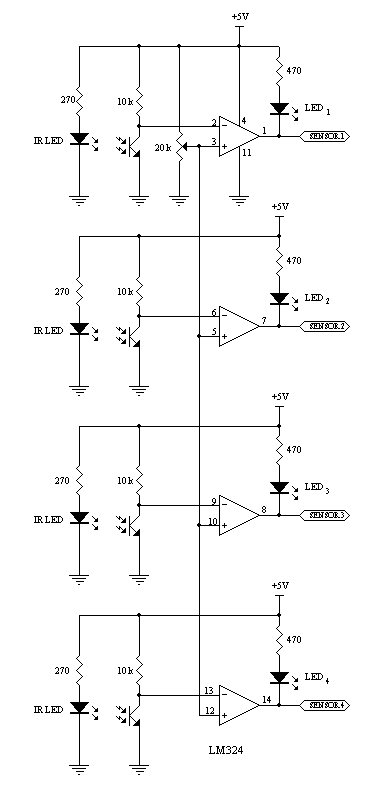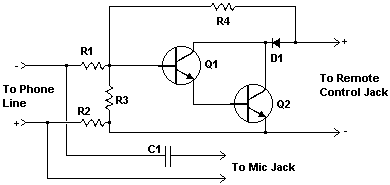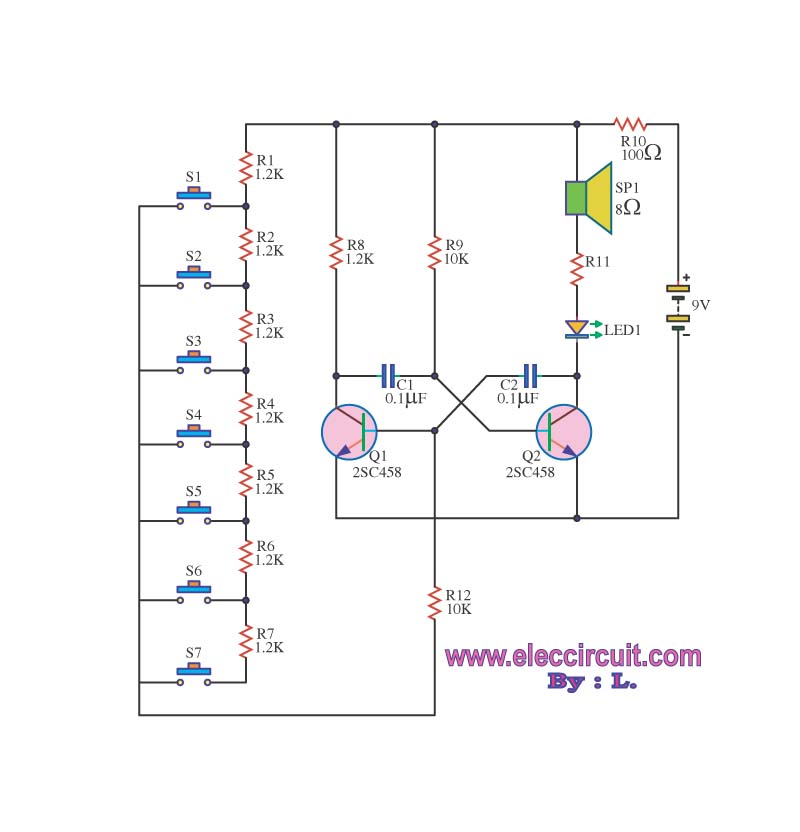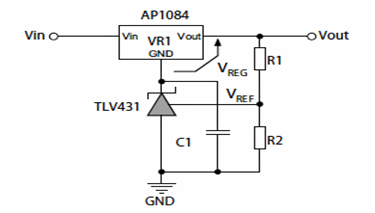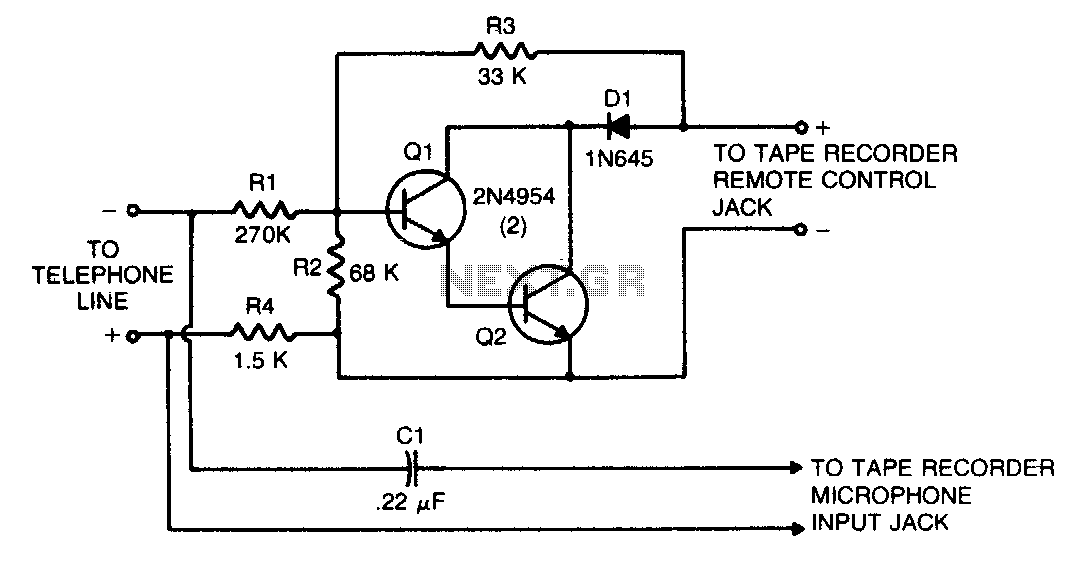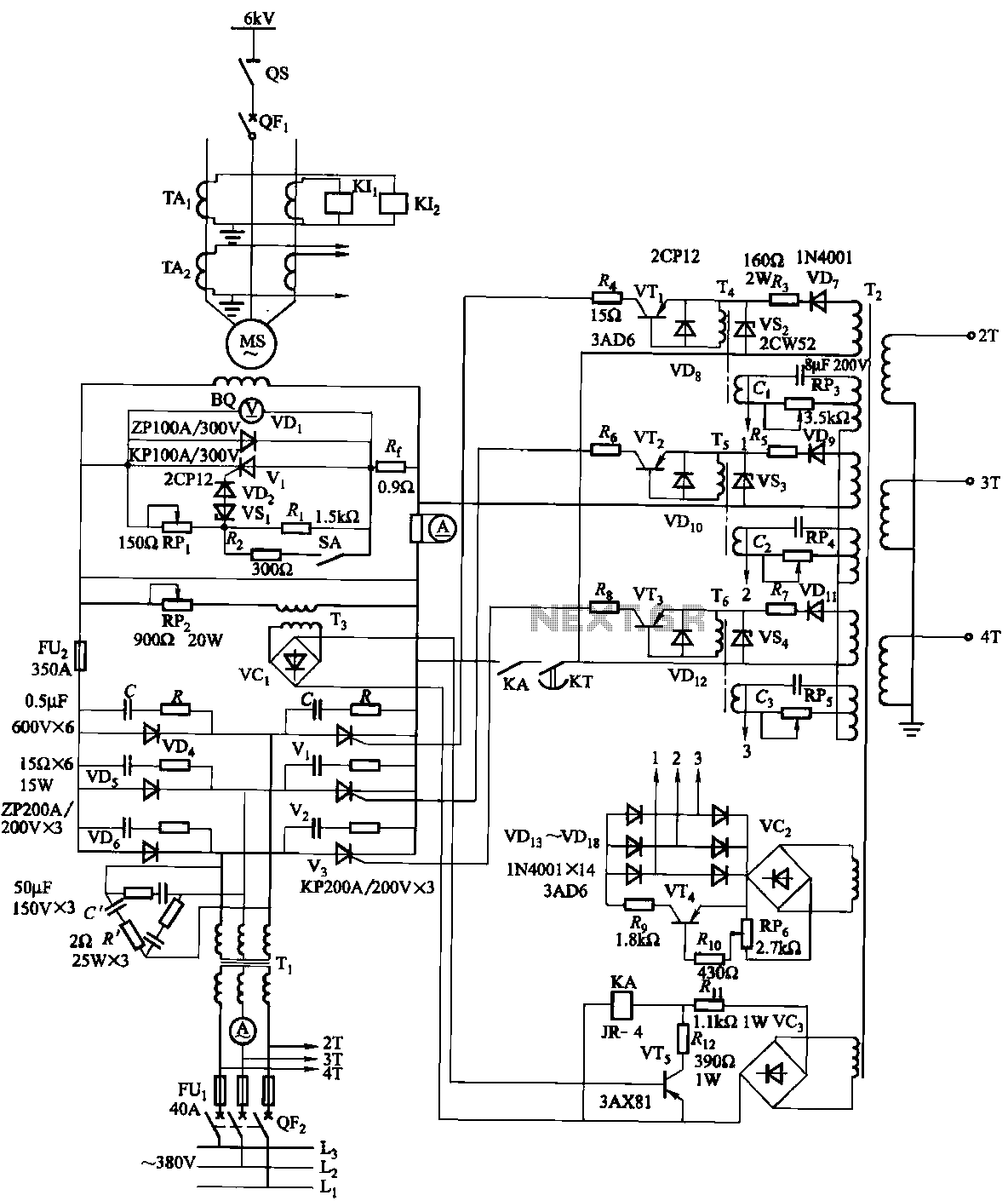
Telephone line based audio muting and light on circuit

The circuit automatically lights a bulb upon the arrival of a telephone ring and simultaneously mutes the audio from the music system or TV while the telephone handset is off-hook. The lighting of the bulb not only indicates an incoming call but also assists in locating the telephone in the dark. When a ring is detected or the handset is off-hook, the built-in transistor of IC1 (opto-coupler) conducts, charging capacitor C1, which subsequently forward biases transistor T1. This causes transistor T1 to conduct, energizing relays RL1, RL2, and RL3. Diode D1, connected in anti-parallel to the built-in diode of IC1 and in shunt with resistor R1, provides a pathway for AC current and limits the voltage across the built-in diode to a safe level during ringing. The RMS value of the ring voltage ranges between 70 and 90 volts RMS. Capacitor C1 maintains the voltage necessary for continuously forward biasing transistor T1, preventing the relays from being energized during the negative half cycles and off-period of the ring signal. Once the handset is lifted, the relays remain energized due to the low-impedance DC path available through the cradle switch and handset for the built-in diode of IC1. After the call is completed and the handset is returned to the cradle, the low-impedance path through the handset is no longer available, causing relays RL1 through RL3 to deactivate. As illustrated, the energized relay RL1 turns on the light, while relay RL2 opens the path to the TV speaker lead. For dual-speaker TVs, relay RL2 should be replaced with a DPDT relay rated at 6V, 200 ohms. Similarly, energization of DPDT relay RL3 opens the leads to the speakers, muting both audio outputs. The NC contacts of relay RL3 should be connected in series with the speakers of the music system, and the NC contacts of relay RL2 should be connected in series with the TV speaker. The NO contact of relay RL1 should be connected in series with a bulb to provide a visual indication.
The circuit operates by utilizing an opto-coupler (IC1) to detect the ringing signal from the telephone line. When the telephone rings, the opto-coupler activates, allowing current to flow through capacitor C1, which charges and maintains the voltage necessary to keep transistor T1 in a forward-biased state. This action energizes the relays responsible for controlling the light and muting the audio devices.
Relay RL1 is responsible for turning on the bulb, providing a clear visual cue for incoming calls. The relays RL2 and RL3 serve to interrupt the audio signals from the TV and music system, respectively. The design allows for the use of a DPDT relay for systems with dual speakers, ensuring that both channels of audio are muted effectively.
The inclusion of diode D1 serves a critical protective function, ensuring that the voltage across the built-in diode of IC1 remains within safe limits during ringing conditions. This is essential for the longevity and reliability of the circuit.
The circuit's operation is designed to be seamless, with the relays remaining energized as long as the handset is off-hook, providing uninterrupted functionality until the call is completed. The design is efficient, utilizing a combination of capacitive and resistive elements to maintain control over the circuit's operation while ensuring safety and reliability during use.The circuit would automatically light a bulb on arrival of a telephone ring and simultaneously mute the music system/TV audio for the duration the telephone handset is off-hook. Lighting of the bulb would not only indicate an incoming call but also help in locating the telephone during darkness.
On arrival of a ring, or when the handset is off-hook, the inbuilt transistor of IC1 (opto-coupler) conducts and capacitor C1 gets charged and, in turn, transistor T1 gets forward biased. As a result, transistor T1 conducts, causing energisation of relays RL1, RL2, and RL3. Diode D1 connected in anti-parallel to inbuilt diode of IC1, in shunt with resistor R1, provides an easy path for AC current and helps in limiting the voltage across inbuilt diode to a safe value during the ringing.
(The RMS value of ring voltage lies between 70 and 90 volts RMS. ) Capacitor C1 maintains necessary voltage for continuously forward biasing transistor T1 so that the relays are not energised during the negative half cycles and off-period of ring signal. Once the handset is picked up, the relays will still remain energised because of low-impedance DC path available (via cradle switch and handset) for the in-built diode of IC1.
After completion of call when handset is placed back on its cradle, the low-impedance path through handset is no more available and thus relays RL1 through RL3 are deactivated. As shown in the figure, the energised relay RL1 switches on the light, while energisation of relay RL2 causes the path of TV speaker lead to be opened.
(For dual-speaker TV, replace relay RL2 with a DPDT relay of 6V, 200 ohm. ) Similarly, energisation of DPDT relay RL3 opens the leads going to the speakers and thus mutes both audio speakers. Use NC` contacts of relay RL3 in series with speakers of music system and NC` contacts of RL2 in series with TV speaker.
Use NO` contact of relay RL1 in series with a bulb to get the visual indication 🔗 External reference
The circuit operates by utilizing an opto-coupler (IC1) to detect the ringing signal from the telephone line. When the telephone rings, the opto-coupler activates, allowing current to flow through capacitor C1, which charges and maintains the voltage necessary to keep transistor T1 in a forward-biased state. This action energizes the relays responsible for controlling the light and muting the audio devices.
Relay RL1 is responsible for turning on the bulb, providing a clear visual cue for incoming calls. The relays RL2 and RL3 serve to interrupt the audio signals from the TV and music system, respectively. The design allows for the use of a DPDT relay for systems with dual speakers, ensuring that both channels of audio are muted effectively.
The inclusion of diode D1 serves a critical protective function, ensuring that the voltage across the built-in diode of IC1 remains within safe limits during ringing conditions. This is essential for the longevity and reliability of the circuit.
The circuit's operation is designed to be seamless, with the relays remaining energized as long as the handset is off-hook, providing uninterrupted functionality until the call is completed. The design is efficient, utilizing a combination of capacitive and resistive elements to maintain control over the circuit's operation while ensuring safety and reliability during use.The circuit would automatically light a bulb on arrival of a telephone ring and simultaneously mute the music system/TV audio for the duration the telephone handset is off-hook. Lighting of the bulb would not only indicate an incoming call but also help in locating the telephone during darkness.
On arrival of a ring, or when the handset is off-hook, the inbuilt transistor of IC1 (opto-coupler) conducts and capacitor C1 gets charged and, in turn, transistor T1 gets forward biased. As a result, transistor T1 conducts, causing energisation of relays RL1, RL2, and RL3. Diode D1 connected in anti-parallel to inbuilt diode of IC1, in shunt with resistor R1, provides an easy path for AC current and helps in limiting the voltage across inbuilt diode to a safe value during the ringing.
(The RMS value of ring voltage lies between 70 and 90 volts RMS. ) Capacitor C1 maintains necessary voltage for continuously forward biasing transistor T1 so that the relays are not energised during the negative half cycles and off-period of ring signal. Once the handset is picked up, the relays will still remain energised because of low-impedance DC path available (via cradle switch and handset) for the in-built diode of IC1.
After completion of call when handset is placed back on its cradle, the low-impedance path through handset is no more available and thus relays RL1 through RL3 are deactivated. As shown in the figure, the energised relay RL1 switches on the light, while energisation of relay RL2 causes the path of TV speaker lead to be opened.
(For dual-speaker TV, replace relay RL2 with a DPDT relay of 6V, 200 ohm. ) Similarly, energisation of DPDT relay RL3 opens the leads going to the speakers and thus mutes both audio speakers. Use NC` contacts of relay RL3 in series with speakers of music system and NC` contacts of RL2 in series with TV speaker.
Use NO` contact of relay RL1 in series with a bulb to get the visual indication 🔗 External reference
